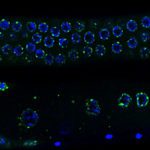Link to Pubmed [PMID] – 19059489
Mol. Phylogenet. Evol. 2009 Feb;50(2):345-63
We show that RNF213 is a nuclear gene suitable for investigating large scale acanthomorph teleosteans interrelationships. The gene recovers many clades already found by several independent studies of acanthomorph molecular phylogenetics and considered as reliable. Moreover, we performed phylogenetic analyses of three other independent nuclear markers, first separately and then of all possible combinations (Dettaï, A., Lecointre, G., 2004. In search of nothothenioid (Teleostei) relatives. Antarct. Sci. 16 (1), 71-85. URL http://dx.doi.org/10.1017/S0954102004) of the four genes. This was coupled with an assessment of the reliability of clades using the repetition index of Li and Lecointre (Li, B., Lecointre, G., 2008. Formalizing reliability in the taxonomic congruence approach. Article accepted by Zoologica Scripta. URL http://dx.doi.org/10.1111/j.1463-6409.2008.00361.x). This index was improved here to handle the incomplete taxonomic overlap among datasets. The results lead to the identification of new reliable clades within the ‘acanthomorph bush’. Within a clade containing the Atherinomorpha, the Mugiloidei, the Plesiopidae, the Blennioidei, the Gobiesocoidei, the Cichlidae and the Pomacentridae, the Plesiopidae is the sister-group of the Mugiloidei. The Apogonidae are closely related to the Gobioidei. A clade named ‘H’ grouping a number of families close to stromateids and scombrids (Stromateidae, Scombridae, Trichiuridae, Chiasmodontidae, Nomeidae, Bramidae, Centrolophidae) is related to another clade named ‘E’ (Aulostomidae, Macrorhamphosidae, Dactylopteridae). The Sciaenidae is closely related to the Haemulidae. Within clade ‘X’ (Dettaï, A., Lecointre, G., 2004. In search of nothothenioid (Teleostei) relatives. Antarct. Sci. 16 (1), 71-85. URL http://dx.doi.org/10.1017/S0954102004), the Cottoidei, the Zoarcoidei, the Gasterosteidae, the Triglidae, the Scorpaenidae, the Sebastidae, the Synanceiidae, and the Congiopodidae form a clade. Within clade ‘L’ (Chen, W.-J., Bonillo, C., Lecointre, G., 2003. Repeatability of clades as a criterion of reliability: a case study for molecular phylogeny of Acanthomorpha (Teleostei) with larger number of taxa. Mol. Phylogenet. Evol. 26, 262-288; Dettaï, A., Lecointre, G., 2004. In search of nothothenioid (Teleostei) relatives. Antarct. Sci. 16 (1), 71-85. URL http://dx.doi.org/10.1017/S0954102004) grouping carangoids with flatfishes and other families (Centropomidae, Menidae, Sphyraenidae, Polynemidae, Echeneidae, Toxotidae, Xiphiidae), carangids are the stem-group of echeneids and coryphaenids, and sphyraenids are the sister-group to the Carangoidei. The Howellidae, the Epigonidae and the Lateolabracidae are closely related. We propose names for most of the clades repeatedly found in acanthomorph phylogenetic studies of various teams of the past decade.

